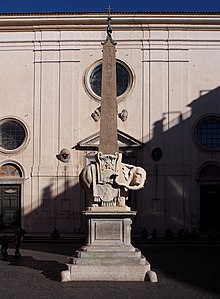Mom Elephant and Baby Elephant Elephant Parents Finger Print Art
| Elephant and Obelisk | |
|---|---|
 | |
 The location of the oblisk today | |
| Creative person | Gian Lorenzo Bernini |
| Twelvemonth | 1667 (1667) |
| Catalogue | 71 |
| Type | Sculpture |
| Medium | Marble |
| Subject area | Elephant |
| Location | Piazza della Minerva, Rome |
| Coordinates | 41°53′52.74″N 12°28′39.26″East / 41.8979833°Due north 12.4775722°E / 41.8979833; 12.4775722 Coordinates: 41°53′52.74″N 12°28′39.26″E / 41.8979833°N 12.4775722°Eastward / 41.8979833; 12.4775722 |
Elephant and Obelisk is a statue of an elephant conveying an obelisk, designed by the Italian artist Gian Lorenzo Bernini. It was unveiled in 1667 in the Piazza della Minerva in Rome, side by side to the church building of Santa Maria sopra Minerva, where it stands today.
The obelisk [edit]
The crimson granite obelisk was discovered in 1665 during excavations near the church of Santa Maria sopra Minerva. Information technology had probably been brought to Rome in the start century Advertizing for the temple to the Egyptian goddess Isis that was located at that place. The obelisk was originally erected by Pharaoh Apries of the Twenty-sixth Dynasty of Egypt,[1] about 580 BC, in his capital Sais.
The obelisk is 5.47 meters tall and is the smallest of the 13 ancient obelisks nowadays in Rome nowadays.[2] Together with pedestal and elephant, the statue stands 12.69 meters alpine.
The obelisk is considered to be one of a pair, the other is in Urbino.
The elephant statue [edit]

Wood cut from Hypnerotomachia Poliphili
The paradigm possibly originated from the Hypnerotomachia Polyphili of 1499. Diverse preparatory drawings done by Bernini exist. One version in Windsor Castle, Uk was probably done in the 1630s when Cardinal Francesco Barberini wished to identify an Egyptian obelisk in front of his family palace, the Palazzo Barberini. Nothing came of this specific projection, but Bernini revived the idea in the 1660s, when Pope Alexander VII, Fabio Chigi, wished to build a similar monument after another Egyptian obelisk had been discovered in Rome.
Various other concepts were explored for this later on committee as attested by preparatory drawings. It is likely that the drawings were used so that the patron could brand a conclusion about which design he wanted. This included a drawing (in Leipzig) of the figure of Fourth dimension belongings a scythe and simultaneously the obelisk. In the Vatican Library there are two pen and ink drawings with other figures property upwardly the obelisk, including one of Hercules, and some other with various allegorical figures supporting the spire.[3] A 3rd version in the Vatican Library shows Bernini adapting on the concept he created in the 1630s, although he added in a larger base, inverse the direction of the elephant'southward orientation, and made its face up appear more friendly than ferocious.[4]
The marble elephant was probably carved by Bernini'south assistant Ercole Ferrata.
The Latin inscription at one side of the pedestal reads: "Allow whatsoever beholder of the carved images of the wisdom of Egypt on the obelisk carried by the elephant, the strongest of beasts, realize that it takes a robust mind to deport solid wisdom."[v]
The statue turned out to be the concluding committee Pope Alexander VII would inquire of Bernini, as the pope died in May 1667. He was succeeded by Pope Clement Ix.
In afterward times [edit]
A similar statue of an elephant conveying an obelisk was erected by Vaccarini in 1736 in front of the Palazzo degli Elefanti in Catania on Sicily.
The statue makes a brief only prominent appearance in the Italian neorealist motion picture Umberto D. (1952). It besides features equally a motif in the novel Adua by Igiaba Scego (2015).
On fifteen November 2016, Rome regime appear they were searching for vandals who broke the left tusk the previous Sunday night and left the piece nearby. Mayor Virginia Raggi said that they will assess the damage to decide how to best reattach the fragment.[vi]
Salvador Dali's painting The Elephants, which depicts ii elephants with elongated legs facing each other while bearing fragmented obelisks, also makes visual references to the statue.
Gallery [edit]
-

Three-quarter view
-

Close-up view from the west
-

View from beneath
-

View against the façade of Santa Maria sopra Minerva
-
The second Obelisk [of the pair of the Elephant and Obelisk], Urbino
Run across also [edit]
- Apries
- Sais
- List of obelisks in Rome
References [edit]
- ^ Heckscher, William Southward. (1947). "Bernini's Elephant and Obelisk". Art Bulletin. XXIX (3): 155–182. doi:10.1080/00043079.1947.11407785.
- ^ 50'Italia. Roma (guida rossa), Touring Club Italiano, Milano 2004
- ^ Wardropper, p29
- ^ Lorenzo, Bernini, Gian. "The Obelisk of the Minerva". www.theeuropeanlibrary.org . Retrieved 2018-02-26 .
- ^ Labib Habachi, The Obelisks of Egypt, 1984
- ^ Palazzo, Chiara (15 Nov 2016). "Rome in daze as Bernini elephant statue vandalized". The Daily Telegraph. Agence France-Presse. Retrieved 15 November 2016.
Farther reading [edit]
- Dickerson, Claude Douglas, Anthony Sigel, and Ian Bruce Wardropper. 2012. "Bernini : Sculpting in Clay : [exhibition, Metropolitan Museum of Art, New York, October iii, 2012 - January six, 2013, Kimbell Art Museum, Fort Worth, Feb 3 - April 14, 2013]
- Cooke, H. 50. 'Iii Unknown Drawings by G. L. Bernini'. The Burlington Magazine 97, no. 631 (1 October 1955): 320–323. doi:x.230
- Napier, David A. 'Bernini's Anthropology: A "Key" to the Piazza San Pietro'. RES: Anthropology and Aesthetics no. 16 (1 October 1988): 17–32. doi:10.2307/20166799
- Popham, A. E. 'Bernini's Drawings of Elephants'. The Burlington Mag 97, no. 633 (1 December 1955): 391. doi:ten.2307/871675
- Posèq, Avigdor W. K. 'The Physiognomy of Bernini's Elephant'. Source: Notes in the History of Art 22, no. iii (1 Apr 2003): 35–46. doi:10.2307/23206724.
Source: https://en.wikipedia.org/wiki/Elephant_and_Obelisk

0 Response to "Mom Elephant and Baby Elephant Elephant Parents Finger Print Art"
Post a Comment